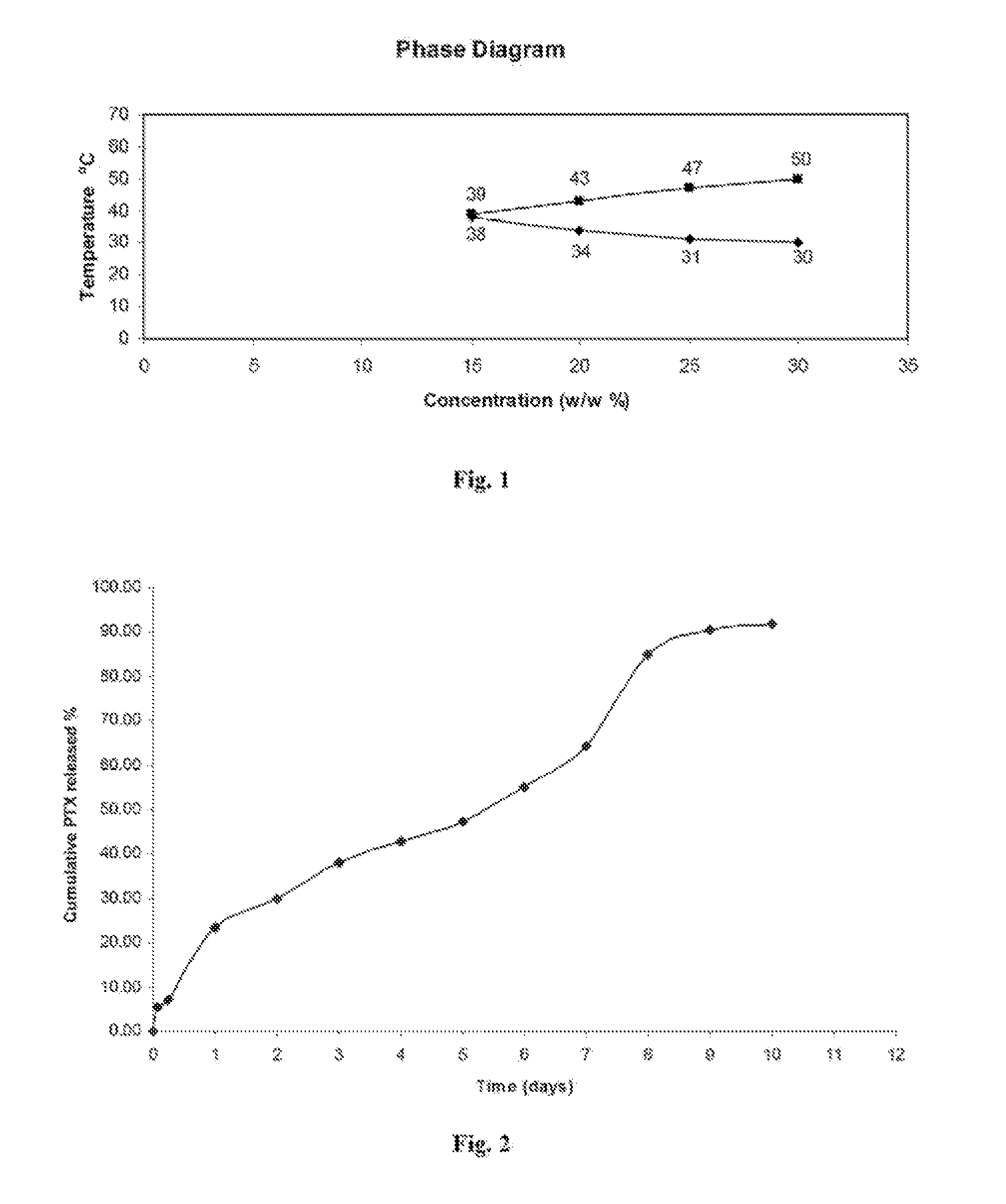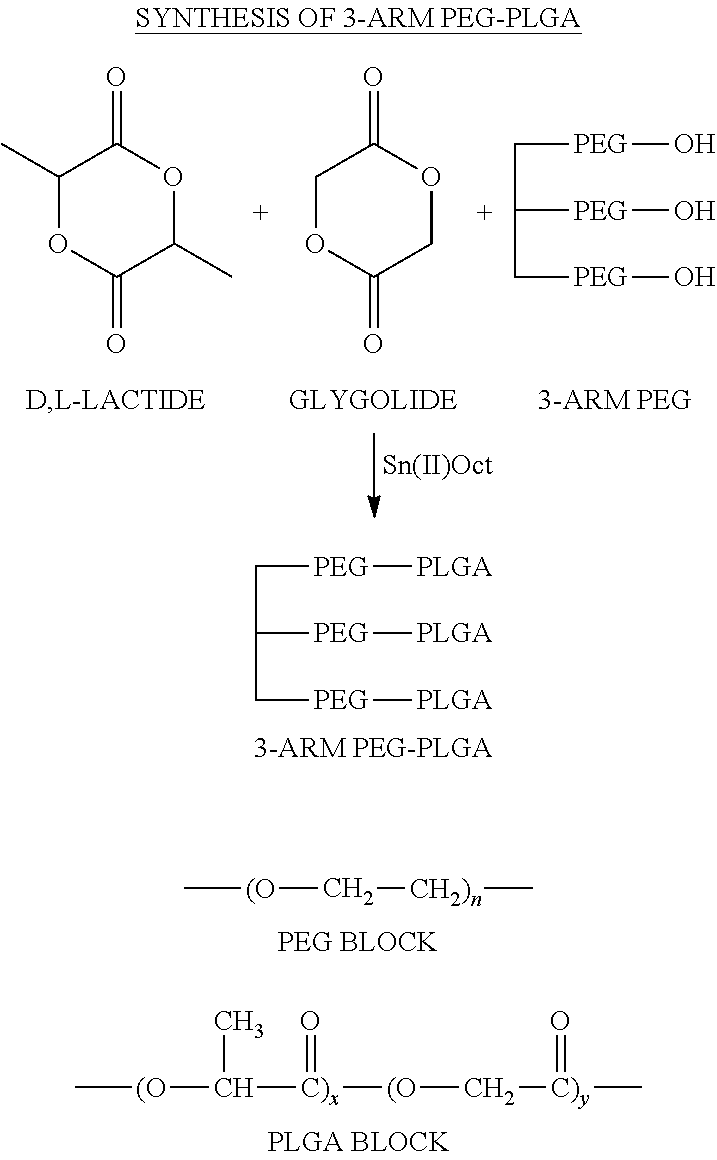Biodegradable thermoresponsive 3-arm polyethylene glycol poly(lactide-co-glycolide) copolymer for ginseng administration
a thermoresponsive, biodegradable technology, applied in the direction of biocide, plant/algae/fungi/lichens ingredients, biodegradable polymers, etc., can solve the problems of not being able to achieve a desirable lcst close to body temperature, polymer is non-biodegradable and unsuitable for drug delivery, and the effect of not being able to achieve a desirable lcs
- Summary
- Abstract
- Description
- Claims
- Application Information
AI Technical Summary
Benefits of technology
Problems solved by technology
Method used
Image
Examples
example 1
Synthesis of 3-Arm PEG-PLGA
[0055]In a glass flask glycerol ethoxylate (Mw=2,000, 1.613 g) was dried under vacuum (1 mmHg) at 150° C. for 3 hours. D,L-lactide (2.829 g) and glycolide (0.568 g) were added to the flask and the mixture was heated with stirring until all solids melt. Polymerization was initiated by the addition of stannous octoate (1 mg). The reaction mixture was heated at 155° C. for 8 hours and cooled to room temperature to give a semi-solid. The interior wall of the flask was rinsed with acetone to remove unreacted monomers and the solid was dried under vacuum. The copolymer was dissolved in cold water to afford a 25% (w / w) solution and separated by heating the solution to 70° C. and decanting the liquid. The purification was repeated twice. After completely dried the copolymer has a weight average molecular weight of 6,820 measured by GPC. GPC was performed on a 4.6×300 mm Styragel HR2 column calibrated with PEG standards using a R1 detector and THF as the eluent.
example 2
Polymer Gelation and Dehydration Properties
[0056]The thermoresponsive behavior of aqueous solutions of the 3-arm PEG-PLGA copolymer including gelation properties and heat induced dehydration properties were studied. The copolymer from Example 1 was dissolved in cold water (0-4° C.) by vortexing in a 4 ml glass vial to give 20% (w / w) aqueous solutions, which were placed in a water bath with temperature set at 26° C. The temperature was increased 1° C. each step, in which the viscosity of the solution and transparency of the solution were visually observed. A gelation temperature was recorded if the solution did not flow in 30 seconds upon inverting the sample vial. Dehydration of the gelled solution was monitored by measuring the liquid released from the gel as a cumulative percentage of its original sample volume at different temperatures starting from the gelation temperature up to 50° C. The results of this study were summarized in FIG. 1 and TABLE 1 below.
TABLE 1T ° C.25333435373...
example 3
Doxorubicin Release
[0058]Doxorubicin was used as a hydrophilic drug in a drug release study using the copolymer of EXAMPLE 1 in a 20% (w / w) aqueous solution. The drug (4 mg) was dissolved in 2 ml of the polymer solution. The drug / polymer solution was filtered through a 0.2 μm syringe and an aliquot of 0.5 ml of the solution was added to each sample vial. The triplet samples were placed in a water bath preheated and stabilized at 37° C. After 10 min a buffer solution of 1×PBS (1 ml, preheated at 37° C.) was added to each sample vial containing a gelled drug / polymer solution. The drug contents in the release media, which were removed and replaced with fresh PBS solutions at each sampling point, were determined at 1, 3, 6 h and then daily for 8 days by a spectrophotometer (SpecraMax M2 by Molecular Devices). The drug release profile is shown in FIG. 3.
PUM
 Login to View More
Login to View More Abstract
Description
Claims
Application Information
 Login to View More
Login to View More - R&D
- Intellectual Property
- Life Sciences
- Materials
- Tech Scout
- Unparalleled Data Quality
- Higher Quality Content
- 60% Fewer Hallucinations
Browse by: Latest US Patents, China's latest patents, Technical Efficacy Thesaurus, Application Domain, Technology Topic, Popular Technical Reports.
© 2025 PatSnap. All rights reserved.Legal|Privacy policy|Modern Slavery Act Transparency Statement|Sitemap|About US| Contact US: help@patsnap.com



